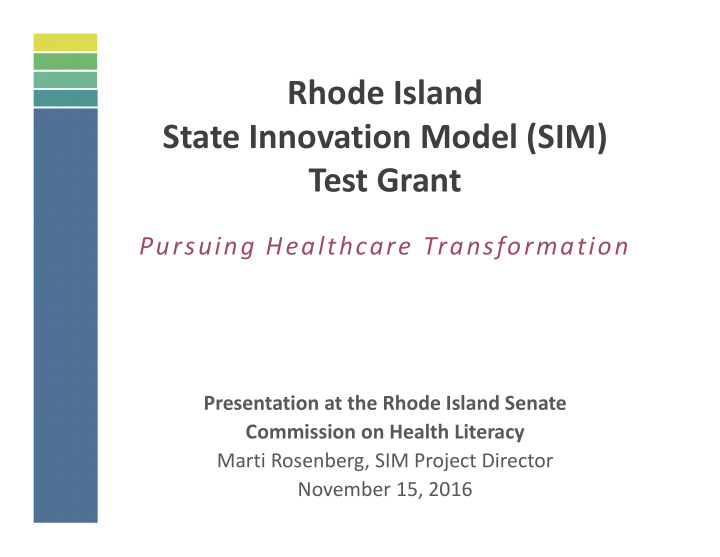



Rhode Island State Innovation Model (SIM) Test Grant Pursuing Healthcare Transformation Presentation at the Rhode Island Senate Commission on Health Literacy Marti Rosenberg, SIM Project Director November 15, 2016
SIM Background • $20 million grant from the Centers for Medicare and Medicaid Services (CMS) • Transforms the way care is delivered and paid for • Enhances the way individuals are engaged in their health 2
SIM Leadership • SIM Steering Committee • Interagency Team 3
The Ultimate Goal The Triple Aim Healthier People Better Care Smarter Spending https://www.cms.gov/Newsroom/MediaReleaseDatabase/Fact‐sheets/2015‐Fact‐sheets‐items/2015‐01‐26.html 4
SIM Theory of Change Improved Population Address Health Empower Support Determinants & Patients Providers of Health Progress Toward Triple Aim 5
SIM Strategies Linking Payment to Outcomes Developing Infrastructure for Quality Care Planning and Aligning for a Healthy Population 6
SIM Investments SIM funds are supporting 3 categories of activities Practice & Data Capacity & Patient Workforce Expertise Empowerment Transformation Expansion Engage patients in Expand the ability of Improve primary care positive health providers and policy and behavioral health behaviors and self‐ makers to use and infrastructure advocacy share data Improved Population Health 7
What determines Population Health? Determinants of Health Genetics [30%] Diet and Safe Housing & Exercise Neighborhoods Individual Social & Substance Education & Behavior Environmental Use Employment [40%] [20%] Seeking Social Supports Medical Care Healthcare [10%] Access to Health Affordability Care Literacy Adapted from Schroeder, SA. (2007). 8
What is the SIM Integrated Population Health Plan? A report describing the physical and behavioral health of Rhode Islanders using 8 focus areas: SIM Health Focus Areas Chronic Serious Disease Children Mental (Diabetes, Maternal & with Social Opioid Use Obesity Tobacco Use Depression Illness (e.g. Heart Child Health & Emotional Disorders Schizo‐ Disease, & Disturbance phrenia) Stroke) 9
SIM Patient Engagement RFP Process Priorities for Patient Engagement Focus on high risk patients Target prevention, detection, & triage Leverage the patient‐provider interaction Connect the provider office to the community Recognize what happens outside the provider office 10
SIM Integration & Alignment Project Facilitating and supporting Integrated Population Health Collaborations in 1‐2 Health Focus areas. 11
Our questions: Expanding SIM’s impact • How does SIM’s focus on Integration and Alignment as one way to tackle Population Health Help line up with your organization’s Us mission and work? Help Us Learn More! – Do you see opportunities to partner Learn or collaborate? More! – Who else should we talk with about SIM? – Your questions and insights. 12
Our Questions: Understanding your work in Population Health • What drives your programmatic decision‐ making in order to help children and families achieve their best health possible? Help • How do you address identified barriers? Systemically? Informally? In other ways? Us Help Us Learn More! Learn • Are you able to expand successful strategies and approaches? More! • How is your understanding of the social determinants of heath influencing tactics, strategy and partnerships? 13
Get Involved Help spread the word: Host a SIM presentation or 1 listening session Stay informed: Join our mailing list to receive public 2 meeting notices Be part of the conversation: Attend SIM public meetings 3 Get involved in the work: Be part of the future IPH 4 Collaborations 14
Contact SIM Marti Rosenberg Marti.Rosenberg@ohic.ri.gov 401‐462‐9659 SIM website: http://www.eohhs.ri.gov/Initiatives/StateInnovationModel.aspx 15
Recommend
More recommend